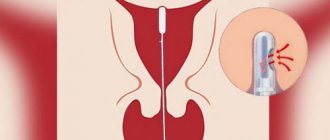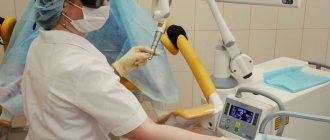Pipelle endometrial biopsy is the removal of a small fragment of the mucous membrane from the uterine cavity for subsequent analysis. The manipulation is carried out using a special catheter, a small flexible plastic tube with a diameter of about 3 mm. Compared to traditional aspiration biopsy, which is performed using a special syringe or vacuum instrument, the pipell procedure is more gentle, does not require anesthesia and takes 7-10 minutes.
The essence of the method
Pipelle biopsy of the endometrium is a minimally invasive method for diagnosing gynecological diseases. This method was named after the scientist who developed it and involves the use of a special pipel device - a thin hollow tube with a rounded end and a piston for aspiration of the soft tissue of the lining uterine layer.
For information! Another name for a pipel biopsy is aspiration, since during the procedure aspiration is carried out, that is, the suction of soft tissue particles by creating a vacuum in the cavity of the manipulation instrument.
A pipel is a thin tube with a diameter of two, three or four millimeters. At its rounded end there is a hole through which fragments of the soft tissue of the endometrium are sucked in when the piston located at the beginning of the instrument is set in motion by the gynecologist and creates a vacuum in the tube. The pipel is inserted through the vagina and cervix into the cavity of the genital organ, but without expanding the cervical canal.
Contraindications
If the risk of post-procedural complications is high or a loop biopsy does not bring the desired effect, the technique is not prescribed. The list of contraindications for the procedure is as follows:
- acute viral infections;
- inflammatory processes in nearby tissues;
- venereal diseases;
- weak immunity;
- long-term therapy with antibiotics;
- diseases of the hematopoietic system;
- pregnancy, breastfeeding;
- uterine bleeding of unknown etiology;
- recent surgical manipulations on the uterus.
To exclude or confirm contraindications, the doctor gives the woman a referral for a standard diagnostic examination. If everything is in order, the date and time of the biopsy will be agreed upon. If viral, inflammatory or infectious processes are diagnosed, appropriate therapy is prescribed. Once treatment is completed and the patient is completely healthy, a diagnostic procedure can be prescribed.
Pros and cons of pipel biopsy
Pipel biopsy has its advantages and disadvantages. First, let's analyze the advantages of the procedure:
- Wide range of applications. The list of indications includes a large number of different gynecological pathologies and diseases.
- Preserving tissue integrity. The procedure is minimally invasive, does not require intervention and is performed without dilating the cervical canal. The integrity of the endometrium is also slightly impaired.
- Carrying out on an outpatient basis in a gynecological office. Registration to a hospital and taking sick leave are not required.
- Short duration. The procedure takes literally a few minutes.
- No need for general anesthesia.
- Reliability, efficiency and information content. Pipelle biopsy allows you to diagnose many pathologies and diseases of the endometrium.
- Minimal pain. The pain is minor and local anesthesia is not necessary.
- Low risks of complications.
Let's consider the existing disadvantages:
- The likelihood of pain, especially with a low pain threshold.
- The method is used mainly in private clinics. The procedure is rarely carried out under compulsory medical insurance policies.
- Relatively high cost of the procedure.
- Existing risks of unpleasant consequences.
- There are some contraindications.
- The need for preparation.
Important! Although the predominance of advantages is obvious, the decision to prescribe a pipel biopsy to a woman should be made by the attending physician, taking into account the patient’s health and medical history.
Cost of a loop biopsy of the cervix
Compared to other methods of collecting material for histological examination, a loop biopsy of the cervix is characterized by an affordable, relatively low cost, which ranges from 1500 to 2800 rubles.
To clarify the cost of a diagnostic and treatment procedure and make an appointment with a specialist at the Healthy Family multidisciplinary clinic, call the number or request a call back. As soon as the administrators see your request, they will immediately contact you and answer all your questions.
Indications for the procedure
Pipelle biopsy is indicated for women in the following cases:
- infertility of unknown origin;
- endometriosis, hyperplasia (pathological growth of the endometrium);
- preparing a woman for IVF;
- endometrial polyps;
- fibroids;
- suspicion of uterine cancer;
- various disorders and disruptions of the menstrual cycle;
- intermenstrual bleeding of unknown origin;
- endometritis (inflammation of the lining of the uterine layer);
- recurrent miscarriage (more than two or three spontaneous abortions in a row);
- Thickening of the endometrium detected during ultrasound examination.
Helpful information! Pipelle biopsy is not included in the list of standard diagnostic procedures: it is prescribed only if indicated.
Increasing your chances of IVF
Not so long ago, this method began to be used not only as an option for examining the uterine cavity, but also as a way to increase the chances of fertilizing an egg in an IVF program. Scientists do not yet have an explanation for this phenomenon, but it has been noted more than once that the chances of implantation were significantly higher if a pipell-sparing biopsy was performed before the fertilization cycle.
Now this area in reproductive medicine is being actively developed, and in the future this method will make the IVF program less expensive. Indeed, in most cases it is necessary to carry out several replantations in a row, and all of them may be unsuccessful.
When is pipel biopsy contraindicated?
Pipelle biopsy has contraindications and is not performed if:
- pregnancy at any stage (including suspected ectopic pregnancy);
- various blood clotting disorders (due to high risks of bleeding);
- inflammatory processes localized in the cervix, ovaries or uterine body;
- urinary tract infections (there is a possibility of infection of the endometrium);
- abnormalities in the structure of the uterus (septa, adhesions);
- menstruation.
The doctor may also identify individual temporary contraindications, such as exacerbation of candidiasis, therapy, and others.
Bleeding from the genital tract
Pipelle biopsy of the endometrium may have consequences in the form of bleeding. In this case, we are talking about damage to the cervix or its internal cavity. Also, this complication can develop due to the fact that the patient has impaired blood clotting. This is why it is so important to conduct this analysis before manipulation.
Normally, blood discharge after sampling can be observed in small quantities and for a rather short period of time. Usually it is a brownish daub or a few drops of scarlet liquid that goes away in two or three days.
Features of preparation for the procedure
In preparation for a pipell biopsy, a woman undergoes a preliminary examination, including an ultrasound of the uterine cavity to exclude pregnancy and identify pathologies, a coagulogram to study blood clotting, and a smear of vaginal flora to detect infections.
Preparation also includes compliance with the following recommendations:
- Cancellation of medications: hormonal drugs (including oral contraceptives), anticoagulants.
- Avoid douching and insertion of vaginal suppositories at least three days before the pipel biopsy.
- Sexual abstinence for three to four days.
- Take an analgesic forty to sixty minutes before the examination (with a low pain threshold and in agreement with the gynecologist).
Why is an endometrial biopsy performed?
A biopsy is the removal of a tissue sample for subsequent examination in the laboratory.
Reference! The endometrium is the mucous membrane lining the uterine cavity. In case of fertilization, it takes part in the formation of the placenta. The thickness of the endometrium varies depending on the phase of the menstrual cycle. In the middle of the cycle, that is, the most favorable time for conception, it has the greatest thickness and increased blood supply. During menstruation, the old layer is shed, and then a new one grows.
The health of the endometrium affects the well-being of a woman’s sexual sphere – her normal sex life and ability to conceive.
Laboratory analysis of endometrial tissue allows us to diagnose:
- its pathological growth (hyperplasia);
- insufficient thickness (atrophy);
- endometritis (inflammatory process);
- endometriosis;
- precancerous conditions;
- endometrial cancer.
Typically, studies are histological or immunohistochemical in nature.
Reference! Histological analysis is the examination of a piece of tissue (biopsy) under a microscope to study its structure. The thinnest sections are made from the sample taken and stained with special substances. Using histology, it is possible to establish the type of tissue (for example, glandular, epithelial, muscle, stromal), the degree of change in its structure, as well as the type of tumor.
Immunohistochemistry is a more modern and differentiated technology. When using it, a tissue section is also performed, which is exposed to reagents. The method allows you to study the receptors of tissue cells, their sensitivity to hormones, as well as the activity of certain genes in them. Thanks to immunohistochemical analysis, it is possible to establish not only the tissue, but also the organ origin of cells. Also predict the rate of tumor growth, the body’s response to chemotherapy, and select hormonal drugs for treatment.
The doctor decides what type of research should be used, as both methods have their own characteristics and limitations.
Sometimes a bacteriological analysis is performed, thanks to which bacterial pathogens that provoke inflammation of the endometrium can be identified.
Diagnoses of “endometrial cancer” and “chronic endometritis”, “endometrial hyperplasia” can be established solely based on the results of histology or immunohistochemistry.
A sample of the endometrium is collected for laboratory testing using curettage or aspiration methods.
Reference! Aspiration is a procedure for removing suction from a cavity or pathological focus.
Aspiration biopsy is performed using a tube with a suction device (syringe or electric suction). Pipelle biopsy is an improved type of aspiration biopsy.
Carrying out a pipel biopsy
Pipelle biopsy is carried out in several stages:
- Placing the patient on the gynecological chair.
- A gynecologist inserts an expanding instrument with a speculum into the patient’s vagina to provide access to the cervical canal.
- Measuring the diameter of the cervical canal using a special measuring device inserted into the cervix (to select the appropriate pipel size).
- Insertion of a special pipell tube into the uterine cavity through the cervical canal.
- Collecting biological material in three different zones through the pipe opening. Aspiration is carried out by the movement of a piston performed by a physician.
- Placing the biomaterial in a test tube or on sterile glass.
- Removing the tool.
- Sending the material to the laboratory for detailed examination.
The entire procedure usually takes no more than 7-10 minutes.
Helpful information! Sometimes, to prevent severe pain and spasm of the cervix (when a pipel is inserted into it), an antispasmodic injection is performed 10-15 minutes before the manipulation.
Loop biopsy during pregnancy
A loop biopsy of the cervix is not prescribed for nulliparous women, because after surgical manipulation a large scar and adhesions form on the surface of the organ. Such deformations can prevent sperm from penetrating into the uterine cavity, which significantly reduces the likelihood of fertilization of the egg.
If pregnancy occurs, it usually proceeds normally, although sometimes women go into early labor, but the procedure does not have a significant impact on these statistics. The elasticity of the cervix is significantly reduced due to the scar formed on it after the loop biopsy. This can complicate the birth process and lead to extensive ruptures, causing heavy internal bleeding. To prevent such complications, the procedure is postponed until the postpartum period.
After the procedure
After the procedure, the woman can return to her usual lifestyle, but follow a gentle regimen, excluding sexual intercourse and intense physical activity for five to seven days. In addition, hypothermia and overheating are prohibited, as are visits to public reservoirs, baths and saunas. It is possible to take an antibacterial drug that has a wide spectrum of action. A hospital stay under medical supervision is not required unless there are complications. The doctor will give detailed recommendations after the pipel biopsy.
After the procedure, pain in the lower abdomen and scanty bleeding may be observed for several days. Typically, such symptoms go away on their own without requiring intervention.
Possible complications
Complications occur infrequently, usually with little experience or low qualifications of the doctor, as well as when the patient does not comply with recommendations. The following consequences are possible:
- Perforation of the uterine wall in the presence of inflammation or careless rude actions of the doctor.
- Infection of the endometrium and its subsequent inflammation (endometritis) in the presence of undetected infections of the genitourinary system.
- Heavy bleeding due to damage to the endometrium. They often occur with decreased blood clotting.
- Disruptions of the menstrual cycle: delay or, on the contrary, early onset, profuseness or pain of menstruation.
Research results
The study is carried out in the laboratory after preliminary processing of the biomaterial. The cellular composition, the presence of malignant mutated cells, the presence of microorganisms (fungi, bacteria), signs of hyperplasia and other changes in the structure of the endometrium, the state of the lining layer receptors, and symptoms of autoimmune lesions are assessed.
The results are either given directly to the patient or transmitted to her attending physician seven to ten days after the pipel biopsy. The conclusion indicates the pathological changes by which the gynecologist makes a diagnosis.
Women's opinions about pipel biopsy
Let's look at a few reviews from patients who underwent pipell endometrial biopsy:
- Natalya: “I had a pipel biopsy done in preparation for pregnancy. I was very afraid of pain, as I am an impatient person. But the most unpleasant moment was the installation of the expander. The insertion of the tube itself is absolutely painless and is not felt at all: it is thin and soft.”
- Alena: “Initially I was afraid of the procedure, because I read on the Internet that it would hurt. But it hurt for a second, as if I had been given an injection. However, I did not take painkillers. You just need to trust your gynecologist and relax as much as possible.”
- Margarita: “I was given anesthetic injections before the procedure, the procedure lasted about twenty minutes. It was a little painful, then there were cramps for several hours. But overall it's tolerable. Much more humane than hysteroscopy, but not always 100% informative.”
- Evgenia: “I had an aspiration biopsy, it didn’t hurt at all. It feels like sweating, like during menstruation. Sex was allowed after three days, but with condoms in the first week. They found the cause of my problem, so I definitely recommend the pipel.”
Pipelle biopsy is a modern and informative diagnostic method that allows you to identify endometrial pathologies and their causes. But the procedure should be carried out by an experienced doctor and only according to indications.
(Rate this article)
Share the news on social networks
Ask a Question! You have questions? Feel free to ask any questions! And our staff specialist will help you. Go>>
- Recommended Articles
- Adnexitis: symptoms and treatment
- When is intrauterine insemination necessary?
- MAP test
« Previous entry
Opinions of doctors and patients about manipulation
Pipelle endometrial biopsy has positive reviews. Patients say that the procedure is absolutely painless. It lasts no more than one minute. It takes much longer to prepare for it. Within a few minutes after collecting the material, the patient can go home. Only in some special cases do doctors leave a woman in the hospital for several hours.
Doctors say that pipell biopsy of the endometrium gives very accurate results. If a regular biopsy examines a specific area that was taken using curettage, then a pipel takes the endometrium from all the walls of the reproductive organ. Experts also report the safety of manipulation. Gynecologists do not have to expand the patient’s cervical canal. After all, this often leads to the development of complications.
Pipe endometrial biopsy is also a safe procedure due to the use of sterile materials. The straws are made of high quality plastic and can only be used once. During curettage, reusable metal devices are used. This often leads to infection and infection. That is why pipel biopsy is the more preferable way to study the condition of the internal cavity of the reproductive organ.
Patients talk about the relatively expensive cost of the procedure. The average price category for pipel biopsy ranges from two to five thousand rubles. However, in government institutions this research is performed absolutely free of charge, provided certain documents are available.











